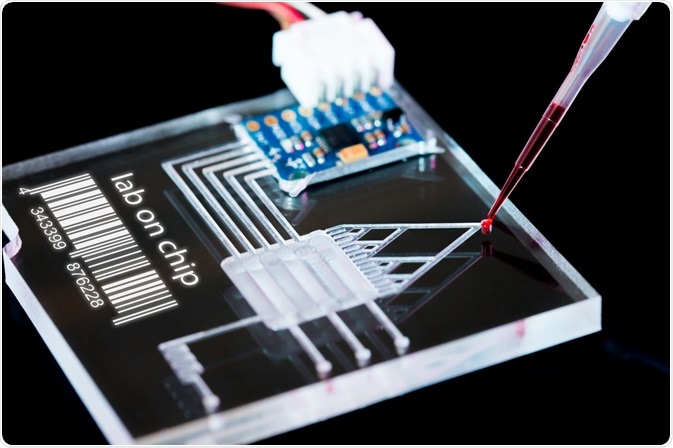Microfluidic systems are non-turbulent, highly ordered, fluid flow systems that are typically used in controlled biological experiments. The size of most microfluidic devices is within the range of a few hundred microns.
 science photo | Shutterstock
science photo | Shutterstock
The foundation of every microfluidic system is two-fold: the behavior of fluids passed through microchannels as well as the development of highly miniaturized devices that contain chambers and tunnels for the flow or containment of these fluids.
The key to microfluidics is that fluids in microliter quantities have an entirely different behavior compared to fluids on a macroscale.
The applications of microfluidics is vast, ranging from early stage clinical analyses to the chemical syntheses of novel compounds, very high-throughput assays of biological compounds, and even to the simulation of living organ systems.
What is the ‘lab-on-a-chip’?
The ability to put an entire laboratory procedure into a simple microsystem has given this technology the name “lab on a chip”. In this case, the chip is defined as the pattern of microchannels in which the fluid flows, which is either molded or engraved.
The link between the microchannels and the macroscale environment outside is via several holes that are excavated through the chip to different sizes, and are used to inject or remove fluids into or from the chip. Within the microfluidic chip, fluids are mixed, separated or directed, as the experiment requires. The outcome is an automated multiplexed system which can achieve high throughput.
In addition, specifically designed systems must be developed to manage the fluids in the microchannels, and these may be present as embedded elements or outside the chip.
What advantages does microfluidics offer?
The use of microfluidics in analysis offers a number of advantages over conventional macroscale analytics due largely to the much reduced size of the individual components of a microfluidic circuit, and the unexpected alterations in the behavior of the fluid in microvolumes, such as a low Reynolds or Grashof number, for instance.
These benefits include the much smaller sample sizes and reagent volume requirements. These items tend to costly or difficult to isolate in large quantities. Therefore, significant cost savings are possible over the whole range of applications.
Also, the opportunities for research are greater because of the extremely low volume of analyte required at microscale. Moreover, multiple analytes can be processed simultaneously because of the reduced space required for each circuit, providing high-throughput solutions.
Microfluidics systems allow heterogeneous systems to be characterized with greater precision because of the high-throughput nature of microfluidic assays in biological and chemical fields. Since single cells and even molecules can be manipulated experimentally in vitro, so that heterogeneity of multiple variables can be characterized in cell populations.
Because of the small size of components, there is greater flexibility of application beyond traditional benchtop applications.
The capability for high-resolution separations and detections is greatly enhanced by the small component size. Extreme sensitivity is possible because of the lowering of the detection limits. The system yields very accurate results and allows precise control of parameters.
Thus, these systems are ideal for highly automated processes with minimal operator handling. They can be utilized to set up multi-stage reactions with multiple functionalities by persons with limited expertise.
The reduced turnaround time and increased productivity with a small device footprint allows for ease of integration into a variety of experimental setups.
The increased portability makes it ideal for point-of-care devices. The ease of use and low production cost also make microfluidic devices attractive. The ease of disposal of these devices and their broad range of application add to their usefulness.
Summary and perspectives
The microfluidic systems thus take advantage of the altered properties of fluids, whether liquids or gases, when used in microscale. The level of control that is offered by microfluidics has changed the way that researchers study the interaction between molecules. The use of this highly efficient tool is expanding into multiple areas of research, especially the field of bioassays.
Sources
- https://gmwgroup.harvard.edu/pubs/pdf/960.pdf
- www.elveflow.com/…/
- https://www.ncbi.nlm.nih.gov/pmc/articles/PMC3574129/
- https://www.cell.com/chem/pdf/S2451-9294(17)30033-5.pdf
Further Reading
- All Microfluidics Content
- What is Microfluidics?
- Microfluidics Applications
- What is Organ-on-a-Chip (OOC)?
- What is Digital Microfluidics (DMF)
Last Updated: Feb 6, 2019

Written by
Dr. Liji Thomas
Dr. Liji Thomas is an OB-GYN, who graduated from the Government Medical College, University of Calicut, Kerala, in 2001. Liji practiced as a full-time consultant in obstetrics/gynecology in a private hospital for a few years following her graduation. She has counseled hundreds of patients facing issues from pregnancy-related problems and infertility, and has been in charge of over 2,000 deliveries, striving always to achieve a normal delivery rather than operative.
Source: Read Full Article